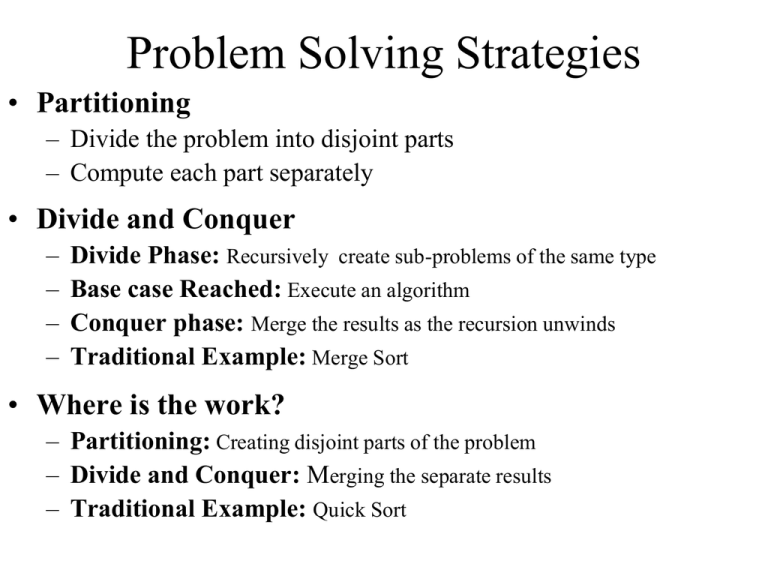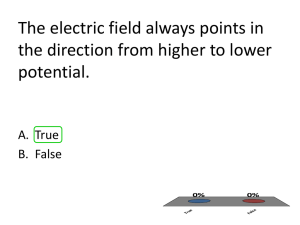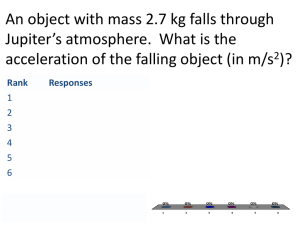Week 3 Power Point Slides
advertisement

Problem Solving Strategies
• Partitioning
– Divide the problem into disjoint parts
– Compute each part separately
• Divide and Conquer
–
–
–
–
Divide Phase: Recursively create sub-problems of the same type
Base case Reached: Execute an algorithm
Conquer phase: Merge the results as the recursion unwinds
Traditional Example: Merge Sort
• Where is the work?
– Partitioning: Creating disjoint parts of the problem
– Divide and Conquer: Merging the separate results
– Traditional Example: Quick Sort
Parallel Sorting Considerations
• Distributed memory
–
–
–
–
Distributed system precision differences can cause unpredictable results
Traditional algorithms can require excessive communication
Modified algorithms minimize communication requirements
Typically, data is scattered to the P processors
• Shared Memory
– Critical sections and Mutual Exclusion locks can inhibit performance
– Modified algorithms eliminate the need for locks
– Each processor can sort N/P data points or they can work in parallel in a
more fine grain manner (no need for processor communication).
Two Related Sorts
Bubble Sort
void bubble(char[] *x, int N)
{ int sorted=0, i, size=N-1;
char* temp;
while (!sorted)
{ sorted=1;
for (i=0;i<size;i++)
{ if (strcmp(x[i],x[i+1]>0)
{ strcpy(temp,x[i]);
strcpy(x[i],x[i+1]);
strcpy(x[i+1],temp);
sorted = 0;
}
}
size--;
} }
1.
2.
Odd-Even Sort
void oddEven(char[] *x, int N)
{ int even=0,sorted=0,i,size=N-1;
char *temp;
while(!sorted)
{ sorted=1;
for(i=even; i<size; i+=2)
{ if(strcmp(x[i],x[i+1]>0)
{ strcpy(temp,x[i]);
strcpy(x[i],x[i+1]);
strcpy(x[i+1],temp);
sorted = 0;
} }
even = 1 – even;
} }
Sequential version: Odd-Even has no advantages
Parallel version: Processors can work independently without data conflicts
Bubble, Odd Even Example
Bubble Pass
Odd Even Pass
Bubble: Smaller values move left one spot per pass. Largest value
move immediately to the end. The loop size can shrink by one each pass.
Odd Even: Large values move only one position per pass. The loop
size cannot shrink. However, all interchanges can occur in parallel.
One Parallel Iteration
Distributed Memory
• Odd Processors:
sendRecv(pr data, pr-1 data);
mergeHigh(pr data, pr-1 data)
if(r<=P-2)
{ sendRecv(pr data, pr+1 data);
mergeLow(pr data, pr+1 data)
}
• Even Processors:
sendRecv(pr data, pr+1 data);
mergeLow(pr data, pr+1 data)
if(r>=1)
{ sendrecv(pr data, Pr-1 data);
mergeHigh(pr data, pr-1 data)
}
Shared Memory
• Odd Processors:
mergeLow(pr data, pr-1 data) ; Barrier
if (r<=P-2) mergeHigh(pr data,pr+1 data)
Barrier
• Even Processors:
mergeHigh(pr data, pr+1 data) ; Barrier
if (r>=1) mergeLow(pr data, pr-1 data)
Barrier
Notation: r = Processor rank, P =
number of processors, pr data is the block
of data belonging to processor, r
Note: P/2 Iterations are necessary
to complete the sort
A Distributed Memory
Implementation
• Scatter the data among available processors
• Locally sort N/P items on each processor
• Even Passes
– Even processors, p<N-1, exchange data with processor, p+1.
– Processors, p and p+1 perform a partial merge where p extracts the
lower half and p+1 extracts the upper half.
• Odd Passes
– Even processors, p>=2, exchange data with processor, p-1.
– Processors, p, and p-1 perform a partial merge where p extracts the
upper half and p-1 extracts the lower half.
• Exchanging Data: MPI_Sendrecv
Partial Merge – Lower keys
Store the lower n keys from arrays a and b into array c
mergeLow(char[] *a, char[] *b, char *c, int n)
{ int countA=0, countB=0, countC=0;
while (countC < n)
{ if (strcmp(a[countA],b[countB])
{
strcpy(c[countC++], a[countA++]); }
else
{
strcpy(c[countC++], a[countB++); }
}
}
To merge upper keys:
1. Initialize the counts to n-1
2. Decrement the counts instead of increment
3. Change the countC < n to countC >= 0
Bitonic Sequence
[3,5,8,9,10,12,14,20]
[95,90,60,40,35,23,18,0]
10,12,14,20]
[95,90,60,40,35,23,18,0]
[3,5,8,9
Increasing and then decreasing where the end can wrap around
Unsorted: 10,20,5,9.3,8,12,14,90,0,60,40,23,35,95,18
Step 1: 10,20 9,5 3,8 14,12 0,90 60,40 23,35 95,18
Step 2: [9,5][10,20][14,12][3,8][0,40][60,90][95,35][23,18]
5,9 10,20 14,12 8,3 0,40 60,90 95,35 23,18
Step 3: [5,9,8,3][14,12,10,20] [95,40,60,90][0,35,23,18]
[5,3][8,9][10,12][14,20] [95,90][60,40][23,35][0,18]
3,5, 8,9, 10,12, 14,20 95,90, 60,40, 35,23, 18,0
Step 4: [3,5,8,9,10,12,14,0] [95,90,60,40,35,23,18,20]
[3,5,8,0] [10,12,14,9] [35,23,18,20][95,90,60,40]
[3,0][8,5] [10,9][14,12] [18,20][35,23] [60,40][95,90[
Sorted: 0,3,5,8,9,10,12,14,18,20,23,35,40,60,90,95
Bitonic
Sort
Bitonic Sorting Functions
void bitonicSort(int lo, int n, int dir) void bitonicMerge(int lo, int n, int dir)
{
{
if (n>1)
if (n>1)
{
{
int m=n/2;
int m=n/2;
for (int i=lo; i<lo+m; i++)
bitonicSort(lo, m, UP);
compareExchange(i, i+m, dir);
bitonicSort(lo+m, m, DOWN;
bitonicMerge(lo, m, dir);
bitonicMerge(lo, n, dir);
bitonicMerge(lo+m, m, dir);
} }
} }
Notes:
1.
2.
dir = 0 for DOWN, and 1 for UP
compareExchange moves
a. low value left if dir = UP
b. high value left if dir = DOWN
Bitonic Sort Partners/Direction
level
j
rank
rank
rank
rank
rank
rank
rank
rank
rank
rank
rank
rank
rank
rank
rank
rank
=
=
=
=
=
=
=
=
=
=
=
=
=
=
=
=
0
1
2
3
4
5
6
7
8
9
10
11
12
13
14
15
partners
partners
partners
partners
partners
partners
partners
partners
partners
partners
partners
partners
partners
partners
partners
partners
1
0
=
=
=
=
=
=
=
=
=
=
=
=
=
=
=
=
1/L,
0/H,
3/H,
2/L,
5/L,
4/H,
7/H,
6/L,
9/L,
8/H,
11/H,
10/L,
13/L,
12/H,
15/H,
14/L,
2
0
2/L
3/L
0/H
1/H
6/H
7/H
4/L
5/L
10/L
11/L
8/H
9/H
14/H
15/H
12/L
13/L
Algorithm Steps
2
3
3
3
1
0
1
2
1/L,
0/H,
3/L,
2/H,
5/H,
4/L,
7/H,
6/L,
9/L,
8/H,
11/L,
10/H,
13/H,
12/L,
15/H,
14/L,
4/L
5/L
6/L
7/L
0/H
1/H
2/H
3/H
12/H
13/H
14/H
15/H
8/L
9/L
10/L
11/L
2/L
3/L
0/H
1/H
6/L
7/L
4/H
5/H
10/H
11/H
8/L
9/L
14/H
15/H
12/L
13/L
1/L,
0/H,
3/L,
2/H,
5/L,
4/H,
7/L,
6/H,
9/H,
8/L,
11/H,
10/L,
13/H,
12/L,
15/H,
14/L,
4
0
4
1
4
2
4
3
8/L
9/L
10/L
11/L
12/L
13/L
14/L
15/L
0/H
1/H
2/H
3/H
4/H
5/H
6/H
7/H
4/L
5/L
6/L
7/L
0/H
1/H
2/H
3/H
12/L
13/L
14/L
15/L
8/H
9/H
10/H
11/H
2/L
3/L
0/H
1/H
6/L
7/L
4/H
5/H
10/L
11/L
8/H
9/H
14/L
15/L
12/H
13/H
1/L
0/H
3/L
2/H
5/L
4/H
7/L
6/H
9/L
8/H
11/L
10/H
13/L
12/H
15/L
14/H
partner = rank ^ (1<<(level-j-1));
direction = ((rank<partner) == ((rank & (1<<level)) ==0))
Java Partner/Direction Code
public static void main(String[] args)
{ int nproc = 16, partner, levels = (int)(Math.log(nproc)/Math.log(2));
for (int rank = 0; rank<nproc; rank++)
{
System.out.printf("rank = %2d partners = ", rank);
for (int level = 1; level <= levels; level++ )
{ for (int j = 0; j < level; j++)
{ partner = rank ^ (1<<(level-j-1));
String dir = ((rank<partner)==((rank&(1<<level))==0))?"L":"H";
System.out.printf("%3d/%s", partner, dir);
}
if (level<levels) System.out.print(", ");
}
System.out.println();
} }
Parallel Bitonic Pseudo code
IF master processor
Create or retrieve data to sort
Scatter it among all processors (including the master)
ELSE
Receive portion to sort
Sort local data using an algorithm of preference
FOR( level = 1; level <= lg(P) ; level++ )
FOR ( j = 0; j<level; j++ )
partner = rank ^ (1<<(level-j-1));
Exchange data with partner
IF ((rank<partner) == ((rank & (1<<level)) ==0))
extract low values from local and received data (mergeLow)
ELSE extract high values from local and received data (mergeHigh)
Gather sorted data at the master
Bucket Sort Partitioning
• Algorithm:
– Assign a range of values to each processor
– Each processor sorts the values assigned
– The resulting values are forwarded to the master
• Steps
1. Scatter N/P numbers to each processor
2. Each Processor
a.
b.
c.
d.
Creates smaller buckets of numbers for designated for each
processor
Sends the designated buckets to the various processors and
receives the designated buckets it expects to receive
Sorts its section
Sends its data back to the processor with rank 0
Bucket Sort Partitioning
Unsorted Numbers
Unsorted Numbers
P1
P2
P3
Pp
Sorted
Sequential Bucket Sort
1.
2.
3.
4.
Drop sections of data to sort
into buckets
Sort each bucket
Copy sorted bucket data back
into the primary array
Complexity O(b * (n/b lg(n/b))
Sorted
Parallel Bucket Sort
Notes: a. Bucket Sort works well for uniformly distributed data
b. Recursively finding mediums from a data sample
(Sample Sort) attempts to equalize bucket sizes
Rank (Enumeration) Sort
1. Count the numbers smaller to each number, src[i] or
duplicates with a smaller index
2. The count is the final array position for x
for (i=0; i<N; i++)
{ count = 0;
for (j=0; j<N; j++)
if (src[i] > src[j] || src[i]=src[j] && j<i) x++;
dest[x] = src[i];
}
3. Shared Memory parallel implementation
a.
b.
Assign groups of numbers to each processor
Find positions of N/P numbers in parallel
Counting Sort
Works on primitive fixed point types: int, char, long, etc.
1. Master scatters the data among the processors
2. In parallel, each processor counts the total
occurrences for each of the N/P data points
3. Processors perform a collective sum operation
4. Processors performs an all-to-all collective prefix sum
operation
5. In parallel, each processor stores the N/P data items
appropriately in the output array
6. Sorted data gathered at the master processor
Note: This logic can be repeated to implement a radix sort
P0
Merge Sort
P0
P4
P0
P0
P2
P1
P2
P4
P3
P4
P6
P5
P6
• Scatter N/P items to each processor
• Sort Phase: Processors sort its data with a method of choice
• Merge Phase: Data routed and a merge is performed at each level
for (gap=1; gap<P; gap*=2)
{ if ((p/gap)%2 != 0) { Send data to p–gap; break; }
else
{
Receive data from p+gap
Merge with local data
} }
P7
Quick Sort
• Slave computers
– Perform the quick sort algorithm
• Base Case: if data length < threshold, send to master (rank = 0)
• Recursive Step: quick sort partition the data
– Request work from the master processor
• If none terminate
• Receive data, sort and send back to master
• Master computer
–
–
–
–
Scatter N/P items to each processor
When receive work request: Send data to slave or termination message
When receive sorted data: Place data correctly in final data list
When data sorted: save data and terminate
Note: Distributed work pools requires load balancing. Processors
maintain local work pools. When the local load queue falls below a
threshold, processors request work from their neighbors







